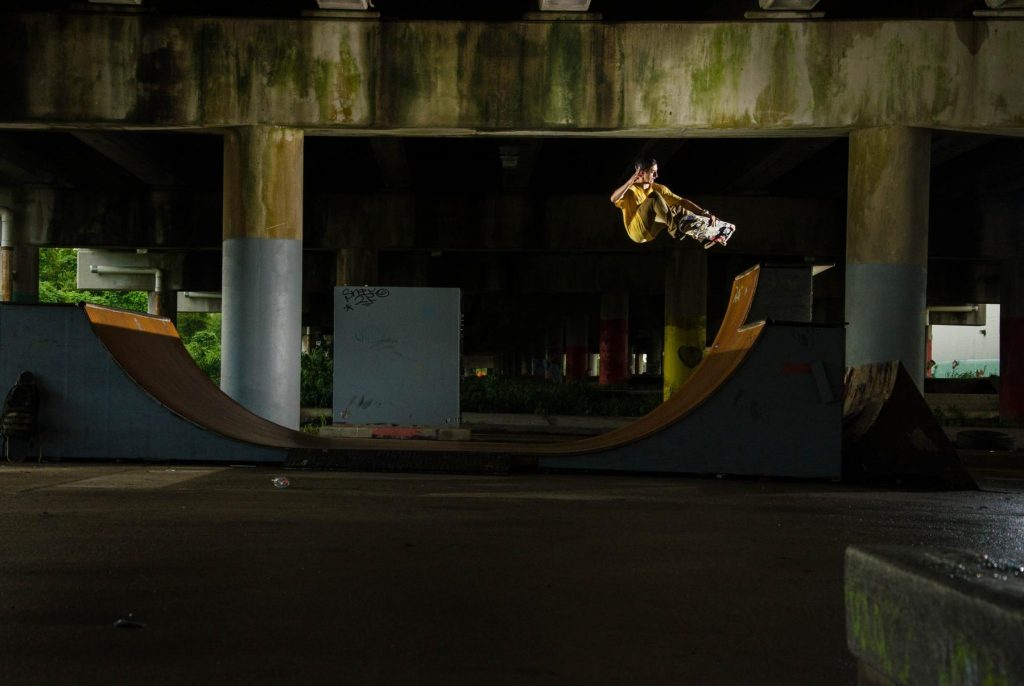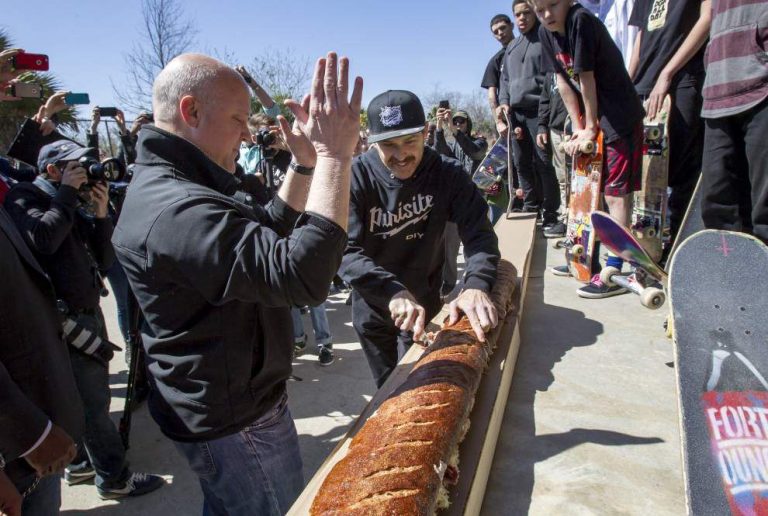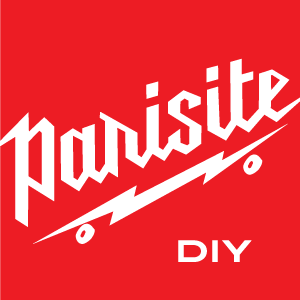
PARISITE MISSION
An ever-rising skatepark in New Orleans—a park designed by skateboarders, built by skateboarders, and funded by all of us working together. Our approach is holistic. We are all Parisite DIY. 1000s of skaters, fundraisers, designers, engineers, government workers, students, and community members are committed to developing and maintaining…

History
Our story starts in 2008, when NOLA was the largest city in the US without a skatepark. A group of young skateboarders found the perfect place to skate: big concrete slab, hidden by trees, a highway, and some railroad tracks. Skaters were so tired of begging for a public skatepark, they went ahead and started building their own, without any permits. They pooled their lunch money, and the ramps grew slowly, one $3 bag of Quikrete at a time…But it didn’t last long.
In May 2012, bulldozers sent by the railroad flattened the park in a matter of minutes.
New Orleans went back to being the biggest U.S. city without a public skatepark. Once again, it seemed like skateboarders just didn’t have any friends. The park was gone, but the community was still there. Two weeks later, skaters started rebuilding—just a few yards away, on blighted public land under a highway. They transformed a trash-strewn dumping ground into a spot that the kids from the neighborhood could safely call their own. Another new skatepark started going up on Paris Avenue. It became known as Parisite. At the same time, other skaters started making numerous trips to City Hall. In fact, a year was spent trudging down every corridor, having conversations with people at every level of city government. Something amazing happened; what the founders found surprised them; people were willing to take a chance on skateboarders.
After some paperwork and some very honest talk about what was expected of us, the City legalized the skatepark and gave us the green light to improve it: it was beyond our wildest dreams. Thanks to a bunch of skateboarders who refused to give-up and the powers-that-be at City Hall, NOLA now has a place for its skate, music and artist community.
City Hall decided to take a chance on the skaters. As a result, the park is now totally legal and up to code.

People come from far and wide, not just to skate or see what we are building, but to pick up a shovel and lend a hand.
Parisite is a legacy project, one that will continue to grow, change, and expand for decades to come.
What's Next
The builds that YOU sponsor are always in development. More funds means MORE infrastructure. More ramps, rails, ledges, smoother flats, a bigger and better street section. Between fundraising, design, approvals, and construction, our phasebuilds take years to complete but the improvements are built to last and are always worth the wait. Our biggest challenge: building permits. The skatepark sits on State land that is leased by the city, under a Federal highway. We must deal with three overlapping jurisdictions: City, State and the Feds. It takes time, and a truckload of persistence, and it helps that we’re skaters because we don’t expect mastery to come easy. The good news: Parisite has already gone through the permitting process twice, so we have a clear road map of how it works. We know the decision makers, and they know us. They also trust us. After an initial period of skepticism, they now see us as solid partners. We expect a smooth road ahead. Piggybacking off the successes of our builds, we hope to maintain momentum as we turn our focus towards building a cultural icon and world-class street plaza. We’ll still have 30,000 square feet of beautiful concrete slab ahead of us to tame and develop.
Thanks for the Support
All Parisite DIYers
New Orleans Recreation Development Commission
Spohn Ranch Skateparks
Tulane University,
Tony Hawk Foundation
Mayor Mitch Landrieu
Capital Projects Administration
Ryan Sheckler & the Sheckler Foundation
the Arts Council of New Orleans
Platforms Fund
Black Rock Arts Foundation
NFL Player Drew Brees
And we’d like to thank you again for all your support and patience. None of this is possible without you!
Location
1606 Pleasure St, New Orleans, LA 70122
Business hours
Monday – Friday … 10 am – 8 pm
Saturday, Sunday … Closed
How to find us
Right on the corner of Paris Ave and Pleasure St.
Drop a line!
Frequently Asked Questions
No, please provide your own hydration
Every Saturday and 12 noon
Usage analysis suggests that in communities with fewer than 200,000 residents need about one neighborhood skatepark for every 25,000 people. Due to economies of scale, larger cities — those with 200,000+ populations — can often meet their needs with one neighborhood skatepark for every 40,000 people.
If your city already has a skatepark and people are not using it, it clearly isn’t meeting the local need. Parks older than 15 years can sometimes feel dated and out-of-touch with modern skateboarding desires. These older parks were typically designed and/or built by people with little skatepark-building experience. Unplanned anomalies in the finish may, at the time, have seemed like minor variances. Today’s skatepark-building standards are much higher than they used to be. Although there are some skateparks built close to 20 years ago that are still considered flawless, today nearly all skateparks designed and built by experienced contractors are technically flawless.
Prefabricated ramps, (the kind you sometimes see installed on old tennis courts), are prone to structural failure even under ordinary wear-and-tear. Kids are hard on structures, and steel or wood/polymer ramps are simply not suitable for municipal use. If your community is serve by a prefabricated skatepark, it’s likely that desires for a new concrete skatepark generally begin emerging after a few years of the prefab park being opened. (Often there is a loud desire for concrete as the city is enchanted by the promise of a cheap solution to their “skateboarding problem.”)
The most common cause for new skatepark advocacy when a city already has a skatepark is that it is too far away for young people that live in other neighborhoods. Rush hour at the skatepark is between 3 to 6 PM. This is usually not enough time for someone to travel across town after school, skate, then travel back home before dinner.
When your city doesn’t have a skatepark, your city is a skatepark. This is the real evidence that the local need is not being met. If there are people skating downtown, there is a reason. The lack of a skatepark is resulting in people skating at the best available terrain in the area.
Skaters can skate anywhere there is enough concrete but some places are better than others. Skaters routinely seek out areas where the surface is smooth, or is shady (during the summer), or covered (during the rain), or features a structure that is fun to play on. For most skaters there is an authenticity about skating in the street on something that wasn’t designed for it. Modern skateparks are good at capturing this aesthetic and innovations in skatepark design are introduced every year. The skatepark’s terrain must be better than what’s available in the streets.
Younger skaters don’t often have the luxury of independent transportation. While youngsters may be able to get to the skatepark on the weekend, the hours between school and dinner often require them to stay in their neighborhoods. They will still skate, but they may be doing it in the street if there is no safe place to ride in the immediate area. This is why every neighborhood should have a skatepark.
If a neighborhood lacks appropriate architecture for skating, skaters with the means to travel will visit other neighborhoods that have better terrain. Skaters without those means will skate wherever there is terrain, appropriate or not.
A typical neighborhood is about 25,000 people. Based on market research, within this area there will be approximately 700 skateboarders. This includes all types of skaters, (once-a-month, longboarders, pocket cruisers, and so on) and certainly they won’t all be using the skatepark at the same time. In general, about 10% of them will be at the skatepark during its most popular times. About 70 skaters can share 10,000 square feet… which is about the size of a neighborhood skatepark.
Larger cities (200,000+ residents) are typically more dense. More people will live in a neighborhood, and so a neighborhood skatepark (10,000 square feet) is enough to serve a larger population of 40,000 residents. There are several factors involved with this scale of service. One reason is that dense cities tend to have more terrain that is appropriate and attractive to skaters. Cities will also typically have better public transportation or comfortable routes to the skatepark.
No more than any other physical activity, hobby, or sport. It’s true that skateboarding magazines and videos often show skaters doing things that seem dangerous. The goal is not to encourage inexperienced skaters to try things that are dangerous but rather to depict those skaters and their teams as the toughest and bravest individuals in skateboarding. It would be unfair to local youth to plan recreational facilities around stylized media depictions of skateboarders.
The benefits of skateboarding are well documented. Skateboarding encourages regular physical activity, gives young people a basis for establishing friendships, and develops confidence. Any healthy activity that a young person is passionate about should be encouraged and supported.
There should be no significant native impact on the area around the new skatepark. Skateparks are popular, so there will probably be a regular presence at the facility. On weekend days the skatepark’s activity will generally peak around 4 PM, and it will be active after school for a few hours. That activity shouldn’t introduce any hardship on the neighbors or the surrounding area because skateparks are most active at the same time that all public parks are most active.
Skateboarding can be risky. The process of learning a new trick or technique involves trying it over and over. At first these attempts are unsuccessful. The skater may fall, but usually a failed attempt at a trick just means that the skater jumps away from the board. Given the high rates of NOT making a trick, one of the first skills a skater develops is how to safely avoid hurting themselves if a trick isn’t successful. In other words, a large part of learning to skate is learning to fall.
Still, people get hurt skateboarding just like they get hurt riding bicycles, playing basketball, or hiking in the woods. Whenever someone gets hurt there is a chance for the victim, or the victim’s family, to seek financial reparation for the injury in the form of a lawsuit. Cities invest a lot of time and money into protecting themselves from these types of lawsuits.
Nearly all severe skateboarding accidents happen in areas where skateboarding is not appropriate. People fall going down long hills, hitting cracks in the pavement, or colliding with motor vehicles. None of these hazards are present at a skatepark. The skatepark produces a safer environment for people to ride skateboards.
Supervised skateparks were once common. Cities felt like skateboarders benefited from having someone at the skatepark that could respond to accidents and ensure that the skatepark rules were obeyed. What cities soon found was that the paying someone to hang out all day and watch skateboarders wasn’t a good use of money. Cities without supervision at their skateparks were just as safe as those that had someone on-site. Cities began to see supervision as an unnecessary expense, and they were right.
Supervision may be handy for special events that require some coordination and control, but for day-to-day use, a skatepark doesn’t need supervision.

No, the park is built and maintained by the skaters.